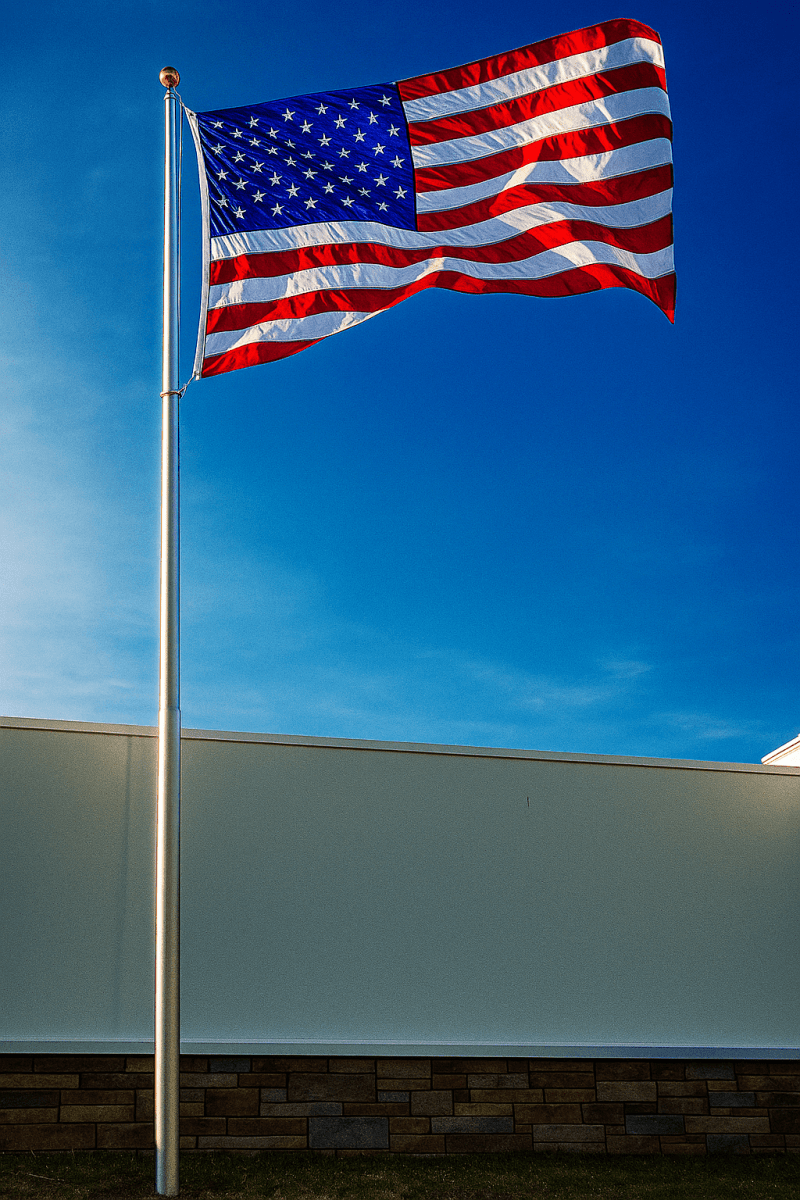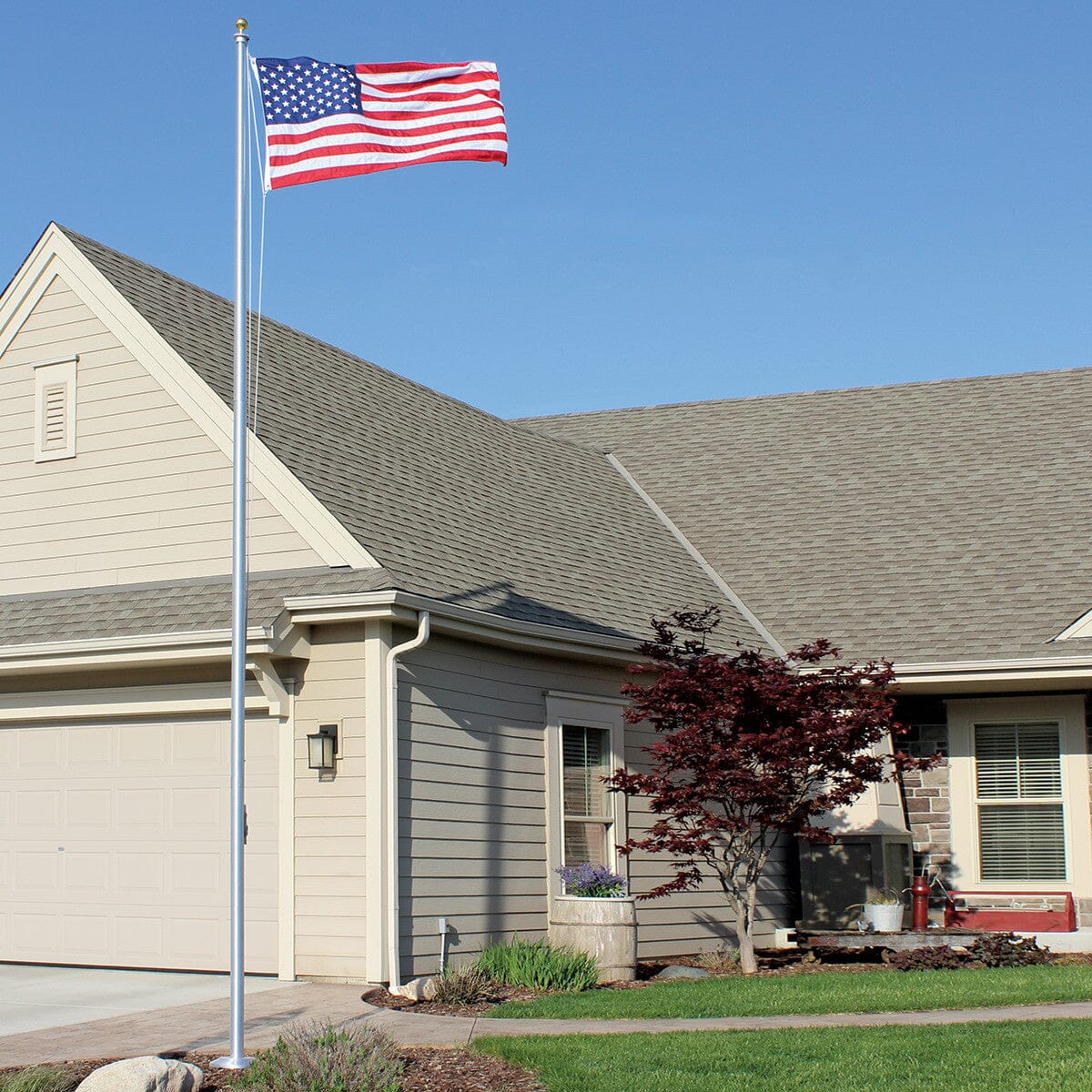A flag flying proudly outside your home or business is much more than a decoration; it’s a symbol that represents freedom, heritage, and unity. For anyone considering installing a flagpole, deciding how to set it securely is an important step. While concrete has traditionally been the go-to method, there’s another option gaining popularity because of its flexibility, practicality, and ease of use. These reasons why you should set your flagpoles in sand just may change the way you think about flagpole installation.
Whether you’re a homeowner looking to add a touch of patriotism to your yard or a business in need of a sturdy display, understanding your foundation options can make all the difference.
Understanding Flagpole Foundations
Before choosing how to install your flagpole, it’s important to understand the different foundation methods available—each with its own set of strengths and challenges.
Traditional Concrete Setting
For decades, concrete has been the standard method for securing flagpoles. Most people associate it with permanent installations, durable bases, and long-lasting results. Concrete is known for providing stability, especially for larger, commercial-grade poles. However, permanence can sometimes work against you. Maintenance or adjustments require breaking through the concrete, making it an extremely labor-intensive task.
The Sand-Setting Method
An alternative that’s quickly rising in popularity is the sand-setting method. With its versatility and ease, sand is not just for amateur DIYers; even professionals are seeing the advantages sand provides for flagpole installations. This approach is especially appealing for those who value convenience without sacrificing reliability. Sand-setting proves that foundations don’t always have to be rock-solid (pun intended) to be effective.
Benefits of Setting a Flagpole in Sand
Choosing sand over concrete comes with several practical advantages. Whether you’re installing a flagpole at home or managing a larger display, these benefits make a strong case for sand as a smart, efficient foundation.
Easier Installation Process
Setting a flagpole in sand is significantly easier than working with concrete. Without needing heavy machinery or excessive tools, this method becomes accessible to homeowners and families. Telescoping flagpoles and pre-packaged DIY kits pair seamlessly with sand-based installations, bridging the gap between simplicity and functionality.
Better Shock Absorption
Wind and ground vibrations can wreak havoc on flagpoles over time. One of the standout benefits of sand over concrete is its ability to absorb these external pressures. Sand acts as a natural shock absorber, reducing strain on your flagpole and increasing longevity. Whether you’re flying the Stars and Stripes or a seasonal banner, sand minimizes the wear and tear caused by constant movement.
Natural Drainage and Corrosion Resistance
Water pooling around flagpole bases can lead to corrosion and weaken the structure over time. Sand naturally facilitates better drainage and prevents unwanted accumulation of moisture. This is particularly advantageous when long-lasting durability matters, especially in areas prone to heavy rain or humidity.
Easier Maintenance and Adjustments
One of the most appealing qualities of sand-setting is flexibility. Want to reposition your flagpole to capture the perfect view of Old Glory in the morning sun? Need to take it down for seasonal changes? With a sand base, it’s all possible without the backbreaking effort of demolishing concrete. Adjustments, re-leveling, or even upgrading to a taller pole involve minimal hassle with this adaptable method.

When To Choose Sand Over Concrete
While concrete may still have its place, there are plenty of situations where sand-setting proves to be the smarter, more flexible choice—especially when ease, mobility, or site conditions come into play.
Residential Applications
If you’re setting up a telescoping flagpole at a home, the ability to adjust and relocate it might be essential. Sand-based installations are perfect for these flexible setups, allowing homeowners to adapt their displays with ease. From seasonal changes to finding the ideal backyard spot, sand works as an accommodating option.
Temporary or Portable Installations
Organizations and individuals involved in temporary or portable displays will love sand-setting. For RV parks, event venues, or holiday displays, the ability to set up and take down without committing to a permanent foundation is invaluable. Sand installations are sturdy but portable, making them perfect for situations where flexibility is key.
Commercial Use
Though often associated with residential settings, sand is also a great option for certain commercial flagpole installations. Businesses that experience heavy winds or require occasional servicing often benefit from the shock absorption and accessibility provided by the sand method. Additionally, businesses operating in leased spaces or areas without concrete-ready access can find this approach particularly practical.
How To Properly Set a Flagpole in Sand
Installing your flagpole in sand is straightforward, but following the right steps ensures a stable, long-lasting setup that holds strong through the seasons.
What You Need
Getting started with sand-setting requires basic materials like clean sand, a flagpole sleeve, and perhaps some gravel for further support. Even with minimal tools, you’re equipped to create a sturdy and flexible foundation.
Step-by-Step Instructions
Start by digging a hole that fits your flagpole sleeve. Ensure the sleeve is centered and add a layer of gravel for drainage if desired. Once this step is complete, fill the hole with sand while compacting it firmly. Continuously check for level and stability while ensuring the pole sits snugly in its base. The compaction stage is important because loose sand will undermine the flagpole’s sturdiness.
Common Mistakes To Avoid
Avoid using unsupportive sand such as beach sand, which is too fine and won’t compact well. Always use a sturdy sleeve to keep the flagpole aligned and stable, and don’t skip compacting the sand. Proper preparation ensures your display remains secure and standing tall.
Is Sand Reliable Enough?
The idea that sand-based flagpoles lack durability is a common misconception. With proper compaction and the addition of a sleeve, sand can provide remarkable stability. Real-world tests and customer experiences confirm that sand-based installations stand the test of time, weather, and use.
Liberty Flagpoles has extensively tested this method and found it excels in areas of both durability and flexibility. Customer feedback frequently highlights how hassle-free adjustments and lower maintenance make sand a favorite, even among skeptics who were initially concerned about stability.

Practical Advantages for Freedom and Flexibility
Choosing sand for your flagpole installation is about more than just convenience. It’s a practical, versatile, and efficient solution for residential, temporary, and even some commercial uses. From easier portability to reduced wear and tear, the benefits of reasons why you should set your flagpoles in sand are too significant to ignore.
Consider giving your flagpole a firm but flexible foundation with the sand-setting method. Explore Liberty Flagpoles’ installation guides and products for step-by-step help, or reach out to our customer service team for personalized support. Your perfect flag display is just a click away.







